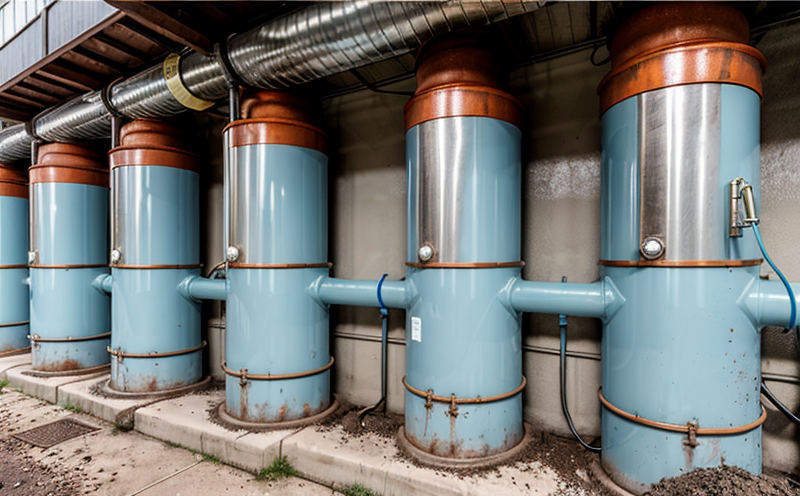ASTM D5673 Aluminium Test in Water Systems
The ASTM D5673 test method is a critical tool used to evaluate the potential for pitting corrosion, scaling, and deposition of aluminium alloys in water systems. This testing method is particularly important in industries such as potable water supply, industrial cooling systems, and power generation facilities where aluminium components are exposed to corrosive environments.
The primary purpose of ASTM D5673 is to determine the resistance of aluminium alloy specimens to localized corrosion under simulated service conditions. The test involves exposing an aluminium alloy specimen in a controlled aqueous environment containing chloride ions for a specified duration, followed by visual inspection and measurement of any pitting or other forms of degradation.
Understanding the corrosion behavior of aluminium alloys is essential as these materials are widely used in water systems due to their high strength-to-weight ratio and excellent resistance to certain types of chemical attack. However, in environments with elevated chloride concentrations, such as seawater, brackish waters, or chlorinated potable water supplies, aluminium can be susceptible to accelerated corrosion processes leading to pitting and eventual failure.
The ASTM D5673 test simulates these real-world conditions by creating an environment that closely mimics the expected service exposure. By subjecting the alloy specimens to this controlled environment, the test provides valuable insights into their resistance to localized corrosion, which is critical for selecting appropriate materials and designing effective protective coatings.
The standard specifies detailed procedures on how to prepare both the specimen and the testing solution. Specimens should be carefully selected based on the specific application and expected service conditions, ensuring they represent real-world exposure accurately. The testing solution typically contains a specific concentration of sodium chloride (NaCl) in water, designed to simulate high-chloride environments.
The test method also provides clear guidelines for evaluating the results visually after immersion. Pitting depths are measured using precise instruments such as micrometers or profilometers. These measurements help quantify the extent of localized corrosion and provide a basis for comparing different materials or coatings.
Additionally, ASTM D5673 offers recommendations on how to interpret these results in terms of serviceability, helping engineers and quality managers make informed decisions about material selection and maintenance schedules.
| Test Parameter | Description |
|---|---|
| Alloy Specimens | Typically 120 mm x 50 mm x 3 mm flat sheets of various aluminium alloys. |
| Testing Solution | Aqueous solution containing 3.5% NaCl by weight. |
| Test Duration | 28 days at 60°C ± 1°C. |
| Evaluation Criteria | Pitting depth measured using micrometers or profilometers. |
This standardized approach ensures consistent and reliable results, which is crucial for maintaining water quality and system integrity. By employing ASTM D5673, stakeholders in the water industry can ensure that their systems are designed to withstand harsh environments, thereby extending operational life and reducing maintenance costs.
For those involved in quality management, compliance officers, R&D engineers, and procurement personnel, understanding these testing protocols is key to ensuring product integrity and regulatory compliance. Proper application of ASTM D5673 can prevent costly failures and improve overall system reliability.
Quality and Reliability Assurance
- Consistent Results: The ASTM D5673 method provides a standardized procedure that ensures consistent testing results across different laboratories.
- Accurate Evaluation: By simulating real-world conditions, the test accurately evaluates the corrosion resistance of aluminium alloys under expected service environments.
The quality and reliability assurance provided by ASTM D5673 are paramount in ensuring that materials used in water systems meet stringent performance standards. This method helps identify potential issues early on, allowing for timely corrective actions to be taken before they lead to significant failures or operational disruptions.
Adherence to this standard also enhances the reputation of manufacturers and suppliers by demonstrating a commitment to excellence and regulatory compliance. For quality managers and procurement officers, compliance with ASTM D5673 can streamline supplier evaluations and certification processes, ensuring that only high-quality materials are selected for use in critical water systems.
Competitive Advantage and Market Impact
The ability to accurately assess the corrosion resistance of aluminium alloys is a significant competitive advantage, especially in industries where long-term reliability and performance are paramount. By using ASTM D5673, manufacturers can demonstrate their commitment to producing high-quality products that meet or exceed industry standards.
Compliance with this standard not only enhances product reputation but also facilitates market access by ensuring that materials meet the requirements set by regulatory bodies such as the International Organization for Standardization (ISO) and ASTM International. This is particularly important in regions where water quality regulations are stringent, such as Europe, North America, and parts of Asia.
For R&D engineers working in the water sector, employing ASTM D5673 can lead to innovations that improve material performance and extend system life. By identifying optimal alloys or coatings through rigorous testing, these professionals can develop new products that not only meet but exceed current standards.
The market impact of using ASTM D5673 extends beyond individual companies; it contributes to the overall improvement in water quality and efficiency across industries. As more organizations adopt this standard, there is a collective shift towards higher-quality materials and better maintenance practices, which benefits everyone involved in the water sector.
Use Cases and Application Examples
- Potable Water Supply: Ensuring that aluminium components used in potable water systems are resistant to pitting corrosion under high-chloride conditions.
- Industrial Cooling Systems: Evaluating the suitability of aluminium alloys for use in cooling towers and other heat exchangers where they may be exposed to aggressive water chemistry.
| Use Case | Application Example |
|---|---|
| Potable Water Supply | Testing aluminium pipes and fittings used in municipal water systems. |
| Industrial Cooling Systems | Evaluating the performance of aluminium heat exchangers in power generation plants. |
The ASTM D5673 test is widely used across various sectors, including industrial water treatment, environmental protection, and energy production. Its application ensures that critical components are not only durable but also environmentally friendly, contributing to sustainable practices in these industries.





